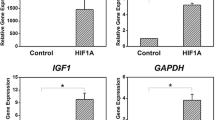Abstract
The success of gene therapy depends largely on the efficacy of gene delivery vector systems that can deliver genes to target organs or cells selectively and efficiently with minimal toxicity. Here, we show that by using the HRE.ppET-1 regulatory element, we were able to restrict expression of the transgene of vascular endothelial growth factor (VEGF) to endothelial cells exclusively in hypoxic conditions. Eukaryotic expression vectors such as pEGFP-HRE.ppET-1, pcDNA3.1-VEGF+Pa, pcDNA3.1-ppET-1+ EGF+Pa, and pcDNA3.1-HRE.ppET-1+VEGF+Pa were constructed by using a series of nuclear molecule handling methods like PCR, enzyme digestion. The recombinant vectors were transfected into HUVEC cells and HL7702 cells by the lipofectin method. GFP expression was observed with a fluorescence microscope to validate the specificity of expression in endothelial cells under the regulation of HRE.ppET-1 element. Cobalt chloride (final concentration 100 μmol/L) was added to the medium to mimic hypoxia in vitro. After transfection of vectors, the expression of VEGF mRNA was detected by RT-PCR, and the expression of VEGF was detected by Western blotting and ELISA methods under normoxia and hypoxia, respectively. The cell proliferation rate was detected by the MTT test. The expression of GFP revealed that the exterior gene was transcripted effectively in endothelial cells regulated by the HRE.ppET-1 element, while the expression of GFP was very weak in nonendothelial cells. The results of RT-PCR, Western blotting and ELISA showed that VEGF gene expression in the pcDNA3.1-HRE.ppET-1+VEGF+Pa group and in the pcDNA3.1-ppET-1+VEGF+Pa group was higher in hypoxia than it was in normoxia (P<0.05). The MTT test showed that the proliferation rate of HUVEC transfected with HPVA under hypoxia exceeded that of the control group. We conclude that the HRE.ppET-1 element was expressed specifically in endothelial cells, and can increase the expression of VEGF in hypoxia and stimulate proliferation of endothelial cells. Taking advantage of these facts could greatly improve the efficiency of gene therapy. The vector would be valuable for various gene transfer studies targeting endothelial cells.
Similar content being viewed by others
References
Lambrechts D, Carmeliet P. VEGF at the neurovascular interface: Therapeutic implications for motor neuron disease. Biochim Biophys Acta, 2006, 1762(11–12): 1109–1121, 16784838, 1:CAS:528:DC%2BD28Xht1CgsLnF
Meng H, Zhang Z, Zhang R, et al. Biphasic effects of exogenous VEGF on VEGF expression of adult neural progenitors. Neurosci Lett, 2006, 393(2–3): 97–101, 16269210, 10.1016/j.neulet.2005.09.044, 1:CAS:528:DC%2BD2MXhtlGit7%2FI
Wang Y, Jin K, Mao X, et al. VEGF-overexpressing transgenic mice show enhanced post-ischemic neurogenesis and neuromigration. J Neurosci Res, 2007, 85(4): 740–747, 17243175, 10.1002/jnr.21169, 1:CAS:528:DC%2BD2sXjsVCqt70%3D
Zhu W, Mao Y, Zhou L F. Reduction of neural and vascular damage by transplantation of VEGF-secreting neural stem cells after cerebral ischemia. Acta Neurochir Suppl, 2005, 95: 393–397, 16463888, 10.1007/3-211-32318-X_80, 1:STN:280:DC%2BD28%2FnvVWisg%3D%3D
Ramanathan M, Pinhal-Enfield G, Hao I, et al. Synergistic up-regulation of vascular endothelial growth factor (VEGF) expression in macrophages by adenosine A2A receptor agonists and endotoxin involves transcriptional regulation via the hypoxia response element in the VEGF promoter. Mol Biol Cell, 2007, 18(1): 14–23, 17065555, 10.1091/mbc.E06-07-0596, 1:CAS:528:DC%2BD2sXmsFygtg%3D%3D
Naidoo V, Naidoo S, Mahabeer R, et al. Cellular distribution of the endothelin system in the human brain. J Chem Neuroanat, 2004, 27(2): 87–98, 15121213, 10.1016/j.jchemneu.2003.12.002, 1:CAS:528:DC%2BD2cXjs1WksLg%3D
Cho J, Lim W, Jang S, et al. Development of an efficient endothelial cell specific vector using promoter and 5′, untranslated sequences from the human preproendothelin-1 gene. Exp Mol Med, 2003, 35(4): 269–274, 14508066, 1:CAS:528:DC%2BD3sXns1Sksb8%3D
Boeckle S, Wagner E. Optimizing targeted gene delivery: chemical modification of viral vectors and synthesis of artificial virus vector systems. AAPS J, 2006, 8(4): E731–42, 17285739, 10.1208/aapsj080483, 1:CAS:528:DC%2BD28XhtlCmtrfE
van Gaal E V, Hennink W E, Crommelin D J, et al. Plasmid engineering for controlled and sustained gene expression for nonviral gene therapy. Pharm Res, 2006, 23(6): 1053–1074, 16715361, 10.1007/s11095-006-0164-2, 1:CAS:528:DC%2BD28XmtFCnsb8%3D
Lyon A R, Sato M, Hajjar R J, et al. Gene therapy: targeting the myocardium. Heart, 2008, 94(1): 89–99, 18083952, 10.1136/hrt.2007.116483, 1:CAS:528:DC%2BD1cXhs1ejtbc%3D
Tanaka T, Kuroki M, Hamada H, et al. Cancer-targeting gene therapy using tropism-modified adenovirus. Anticancer Res, 2007, 27(6A): 3679–3684, 17970028, 1:CAS:528:DC%2BD2sXhtlSltL%2FP
Jeong C H, Lee Y M, Choi K S, et al. Hypoxia-responsive element-mediated soluble Tie2 vector exhibits an anti-angiogenic activity in vitro under hypoxic condition. Int J Oncol, 2005, 26(1): 211–216, 15586242, 1:CAS:528:DC%2BD2MXmsFWhtg%3D%3D
Jiang B, Dong H, Zhang Z, et al. Hypoxic response elements control expression of human vascular endothelial growth factor(165) genes transferred to ischemia myocardium in vivo and in vitro. J Gene Med, 2007, 9(9): 788–796, 17610292, 10.1002/jgm.1070, 1:CAS:528:DC%2BD2sXhtFClu7jF
Binley K, Askham Z, Martin L, et al. Hypoxia-mediated tumour targeting. Gene Ther, 2003, 10(7): 540–549, 12646859, 10.1038/sj.gt.3301944, 1:CAS:528:DC%2BD3sXitFKms7k%3D
Liu J, Harada H, Ogura M, et al. Adenovirus-mediated hypoxiatargeting cytosine deaminase gene therapy enhances radiotherapy in tumour xenografts. Br J Cancer, 2007, 96(12): 1871–1878, 17519901, 10.1038/sj.bjc.6603812, 1:CAS:528:DC%2BD2sXmtlyqtbc%3D
Matzow T, Cowen R L, Williams K J, et al. Hypoxia-targeted over-expression of carboxylesterase as a means of increasing tumour sensitivity to irinotecan (CPT-11). J Gene Med, 2007, 9(4): 244–252, 17397102, 10.1002/jgm.1016, 1:CAS:528:DC%2BD2sXmt1aqtrw%3D
Li L, Qu Y, Li J, et al. Relationship between HIF-1alpha expression and neuronal apoptosis in neonatal rats with hypoxia-ischemia brain injury. Brain Res, 2007, 1180: 133–139, 17920049, 10.1016/j.brainres.2007.08.059, 1:CAS:528:DC%2BD2sXht1Grs7bE
Varda-Bloom N, Shaish A, Gonen A, et al. Tissue-specific gene therapy directed to tumor angiogenesis. Gene Ther, 2001, 8(11): 819–827, 11423929, 10.1038/sj.gt.3301472, 1:CAS:528:DC%2BD3MXktFOrsbc%3D
Shen F, Su H, Fan Y, et al. Adeno-associated viral-vector-mediated hypoxia-inducible vascular endothelial growth factor gene expression attenuates ischemic brain injury after focal cerebral ischemia in mice. Stroke, 2006, 37(10): 2601–2606, 16946160, 10.1161/01.STR.0000240407.14765.e8, 1:CAS:528:DC%2BD28Xps1Ggtrw%3D
Author information
Authors and Affiliations
Corresponding author
Additional information
Supported by the National Natural Science Foundation of China (Grant No. 30500541)
Rights and permissions
About this article
Cite this article
Zheng, X., Zhang, S., Yang, Y. et al. The targeting expression of the vascular endothelial growth factor gene in endothelial cells regulated by HRE.ppET-1. SCI CHINA SER C 51, 959–965 (2008). https://doi.org/10.1007/s11427-008-0116-7
Received:
Accepted:
Published:
Issue Date:
DOI: https://doi.org/10.1007/s11427-008-0116-7




